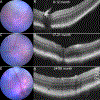Characterization and identification of measurable endpoints in a mouse model featuring age-related retinal pathologies: a platform to test therapies
- PMID: 35589984
- PMCID: PMC10041606
- DOI: 10.1038/s41374-022-00795-7
Characterization and identification of measurable endpoints in a mouse model featuring age-related retinal pathologies: a platform to test therapies
Abstract
Apolipoprotein B100 (apoB100) is the structural protein of cholesterol carriers including low-density lipoproteins. It is a constituent of sub-retinal pigment epithelial (sub-RPE) deposits and pro-atherogenic plaques, hallmarks of early dry age-related macular degeneration (AMD), an ocular neurodegenerative blinding disease, and cardiovascular disease, respectively. Herein, we characterized the retinal pathology of transgenic mice expressing mouse apoB100 in order to catalog their functional and morphological ocular phenotypes as a function of age and establish measurable endpoints for their use as a mouse model to test potential therapies. ApoB100 mice were found to exhibit an age-related decline in retinal function, as measured by electroretinogram (ERG) recordings of their scotopic a-wave, scotopic b-wave; and c-wave amplitudes. ApoB100 mice also displayed a buildup of the cholesterol carrier, apolipoprotein E (apoE) within and below the supporting extracellular matrix, Bruch's membrane (BrM), along with BrM thickening, and accumulation of thin diffuse electron-dense sub-RPE deposits, the severity of which increased with age. Moreover, the combination of apoB100 and advanced age were found to be associated with RPE morphological changes and the presence of sub-retinal immune cells as visualized in RPE-choroid flatmounts. Finally, aged apoB100 mice showed higher levels of circulating and ocular pro-inflammatory cytokines, supporting a link between age and increased local and systemic inflammation. Collectively, the data support the use of aged apoB100 mice as a platform to evaluate potential therapies for retinal degeneration, specifically drugs intended to target removal of lipids from Bruch's membrane and/or alleviate ocular inflammation.
© 2022. The Author(s), under exclusive licence to United States and Canadian Academy of Pathology.
Conflict of interest statement
Figures






Similar articles
-
Mice that produce ApoB100 lipoproteins in the RPE do not develop drusen yet are still a valuable experimental system.Invest Ophthalmol Vis Sci. 2014 Oct 14;55(11):7285-95. doi: 10.1167/iovs.14-15195. Invest Ophthalmol Vis Sci. 2014. PMID: 25316721 Free PMC article.
-
APOB100 transgenic mice exemplify how the systemic circulation content may affect the retina without altering retinal cholesterol input.Cell Mol Life Sci. 2024 Jan 22;81(1):52. doi: 10.1007/s00018-023-05056-4. Cell Mol Life Sci. 2024. PMID: 38253888 Free PMC article.
-
A human apoB100 transgenic mouse expresses human apoB100 in the RPE and develops features of early AMD.Exp Eye Res. 2009 Jun;88(6):1115-23. doi: 10.1016/j.exer.2009.01.017. Epub 2009 Feb 7. Exp Eye Res. 2009. PMID: 19450445 Free PMC article.
-
Bruch's membrane pathology: A mechanistic perspective.Eur J Ophthalmol. 2020 Nov;30(6):1195-1206. doi: 10.1177/1120672120919337. Epub 2020 Apr 28. Eur J Ophthalmol. 2020. PMID: 32345040 Review.
-
Soft Drusen in Age-Related Macular Degeneration: Biology and Targeting Via the Oil Spill Strategies.Invest Ophthalmol Vis Sci. 2018 Mar 20;59(4):AMD160-AMD181. doi: 10.1167/iovs.18-24882. Invest Ophthalmol Vis Sci. 2018. PMID: 30357336 Free PMC article. Review.
Cited by
-
Cholesterol metabolism: physiological regulation and diseases.MedComm (2020). 2024 Feb 24;5(2):e476. doi: 10.1002/mco2.476. eCollection 2024 Feb. MedComm (2020). 2024. PMID: 38405060 Free PMC article. Review.
-
Potential therapeutic targets for age-related macular degeneration: The nuclear option.Prog Retin Eye Res. 2023 May;94:101130. doi: 10.1016/j.preteyeres.2022.101130. Epub 2022 Oct 8. Prog Retin Eye Res. 2023. PMID: 36220751 Free PMC article. Review.
-
Age- and sex- divergent translatomic responses of the mouse retinal pigmented epithelium.Neurobiol Aging. 2024 Aug;140:41-59. doi: 10.1016/j.neurobiolaging.2024.04.012. Epub 2024 May 3. Neurobiol Aging. 2024. PMID: 38723422 Free PMC article.
References
-
- Friedman DS, O’Colmain BJ, Munoz B, Tomany SC, McCarty C, de Jong PT et al. Prevalence of age-related macular degeneration in the United States. Arch Ophthalmol 122, 564–572 (2004). - PubMed
-
- Li JQ, Welchowski T, Schmid M, Mauschitz MM, Holz FG & Finger RP Prevalence and incidence of age-related macular degeneration in Europe: a systematic review and meta-analysis. Br J Ophthalmol 104, 1077–1084 (2020). - PubMed
-
- Klein R, Peto T, Bird A & Vannewkirk MR The epidemiology of age-related macular degeneration. Am J Ophthalmol 137, 486–495 (2004). - PubMed
Publication types
MeSH terms
Substances
Grants and funding
LinkOut - more resources
Full Text Sources
Medical
Miscellaneous

